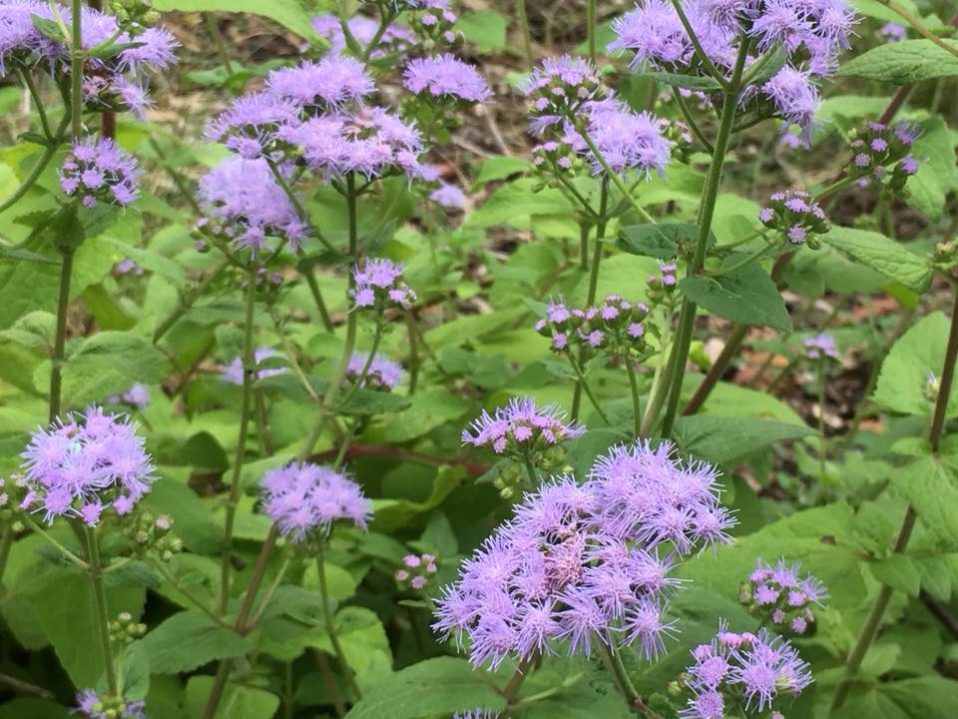Wildlife Wednesday: The Glory of Mistflower
Purple Mistflower (Conoclinium coelestinum) aka Blue Mistflower is a common late summer and autumn blooming wildflower, found over much of the state of Texas. This bushy showy wildflower is extremely popular with pollinators and other insects, because of the copious amounts of nectar it produces on its bounteous small flowers. Recently, our naturalists have been watching a wide variety cool and interesting insects visiting the plant, which has been blooming in the Pocket Prairie and wildflower gardens around the Nature Center. Here’s a little review of some of the creatures we’ve found out on our Mistflower.
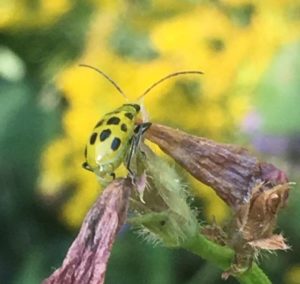 People don’t usually think of beetles as pollinators, but we’ve recently found Spotted Cucumber Beetles (Diabrotica undecimpunctata) flying between the flowers in the park, feeding on nectar and pollen from a variety of Fall wildflowers, like Mistflower, Sunflowers, and Goldenrod. The tiny leaf beetles are only about .64 cm (.25 inches) long. There are 2 generations per breeding season in the South, and we are currently enjoying the 2nd generation of adults for the year. These adults will most like overwinter in forest and garden leaf litter. The name “cucumber beetle” comes from the larva’s habit of feeding on the roots of cucumber plants, as well as other gourd and melon species.
People don’t usually think of beetles as pollinators, but we’ve recently found Spotted Cucumber Beetles (Diabrotica undecimpunctata) flying between the flowers in the park, feeding on nectar and pollen from a variety of Fall wildflowers, like Mistflower, Sunflowers, and Goldenrod. The tiny leaf beetles are only about .64 cm (.25 inches) long. There are 2 generations per breeding season in the South, and we are currently enjoying the 2nd generation of adults for the year. These adults will most like overwinter in forest and garden leaf litter. The name “cucumber beetle” comes from the larva’s habit of feeding on the roots of cucumber plants, as well as other gourd and melon species.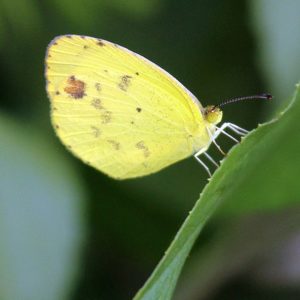
The tiny flowers of mistflower are very popular with smaller butterflies, like Skippers and Little Yellows (Pyrisitia lisa). This small butterfly is aptly named, reaching a wing span of only 4.4 cm (1.73 inches). We seem to get an influx of them this time of year, because of the eclosion (emergence from the pupal case/chrysalis) of the last brood of the season in this region, and migration of more northerly populations to the South. The caterpillars feed on Partridge Pea, a native legume that grows in prairies and grassy fields.
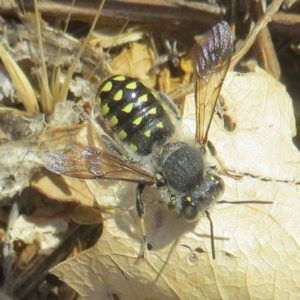 Wool Carder Bees (Anthidium maculosum) are solitary bees, and are just a bit shorter than honeybees, but thicker-bodied. Unlike honeybees, the males males are larger than the females and territorial, and they survive after mating. The females mate with various different males, and establish a nest to lay eggs and raise young by themselves. They are referred to as “carder bees”, because of their habit of gathering plant hairs and fibers to construct their nests.
Wool Carder Bees (Anthidium maculosum) are solitary bees, and are just a bit shorter than honeybees, but thicker-bodied. Unlike honeybees, the males males are larger than the females and territorial, and they survive after mating. The females mate with various different males, and establish a nest to lay eggs and raise young by themselves. They are referred to as “carder bees”, because of their habit of gathering plant hairs and fibers to construct their nests.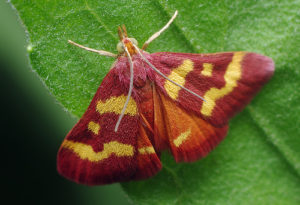
Tiny little moths, like this Coffee-loving Pyrausta (Pyrausta tyralis) are also covering. These dainty colorful moths only reach a wingspan of 1.7 cm (.67 inches). Their numbers suddenly jump this time of year, here in Houston, along with many other newly emerging and migrating moths. This species gets its name from the larval host plant, Wild Coffee. They have many other similarly patterned and similarly sized relatives in the same genus.
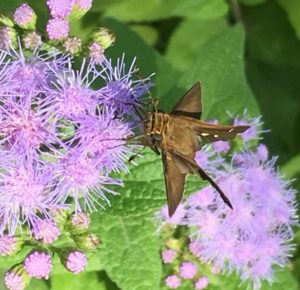 Well, we hope you enjoyed our mini review of some of the insects that have been visiting our Mistflower, here at the Nature Discovery Center. Also, we hope you will consider this beautiful and robust plant for your own home garden, both as decoration and food for wild pollinators.
Well, we hope you enjoyed our mini review of some of the insects that have been visiting our Mistflower, here at the Nature Discovery Center. Also, we hope you will consider this beautiful and robust plant for your own home garden, both as decoration and food for wild pollinators.
If you get a chance, come out to the park on a sunny day, and see for yourself whio is visiting the mistflower!
Thanks for joining us, and see you soon!
Eric Duran
Staff Naturalist
photographs: Eric Duran | NDC; Little Yellow by Charles J. Sharp | Wiki; Wool Carder Bee by Jerry Friedman | Wiki; Pyrausta Moth by Thomas Shahan | Flickr


